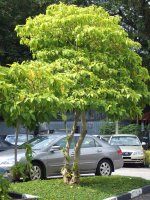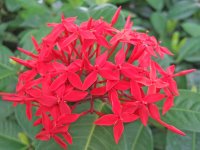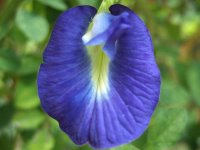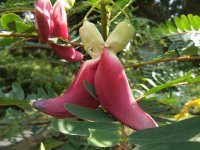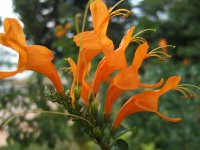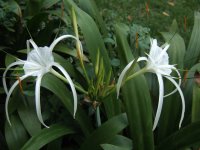Brunfelsia
Yesterday, Today and Tomorrow is the common name given to this genus of plants because their flowers lasted only three days. All the species originated from Central and South America.
They are evergreen shrubs and have branches from the base spreading out to form broad shrubs. The height varies from 4 feet to 6 feet. The leaves are rich green and leathery, usually from 3-6 inches long.Their flowers are slaver-shaped with a long tube. There are five petals and the flowers are fragrant and borne in terminal cymes of 1 to 10 flowers.
Brunfelsias are excellent plants for dry areas because the plants produce an abundance of flowers lasting only 3 days, but may bloom several times during the year.
Most gardeners pampered them with lots of water and having their leaves sprayed during watering. This should not be done because the flower buds will only form in the dry heat. Soft water are preferred than those directly from the water tap.
The soil should be kept on the dry side. Sandy loam will suit them better than other soil where peat is incorporated. One of the good places to have these plants is next to the house where there is some morning sun. Make sure that they are not directly below where water is collected from the roof.
Humus based fertilizers are recommended because inorganic fertilizers or chemical-based fertilizers tend to change the soil structure quickly thus providing less oxigen to the roots. The yellowing of the leaves is common among Brunfelsia. The reason being less oxygen to the roots, too much water and chlorinated tap
There are many species of Brunfelsias. Below are some of them:
Brunfelsia americana - A small shrub of about 6 feet. Unlike the rest, it does not branch from the base. It is very slow in growth. Its flowers are deep yellow, turning to white on the last day. They
do not produce an abundance of flowers. The plant is propagated by cuttings.
Brunfelsia uniflora (syn. B. hopeana) is more robust. The flowers turn from violet to pale blue to white. The height of the plant is about 12 feet or more. This is spreading shrub and has profusion of flowers at the start of rain. The flowers are borne singly on a stalk. It is easy to propagate this plant from cuttings.
Brunfelsia eximia has small flowers and leaves.
Brunfelsia lactifolia is a larger specie and has broad leaves and large flowers.
Generally cuttings are difficult to root. It is easier to buy the plants than to root them. The established cuttings should be transplanted into 6-inch pots before planting out into the flower beds.
Brunfelsia are also popular as pot plants. They are also used for hedges but the depth of the hedge will be about 5 feet.

They are evergreen shrubs and have branches from the base spreading out to form broad shrubs. The height varies from 4 feet to 6 feet. The leaves are rich green and leathery, usually from 3-6 inches long.Their flowers are slaver-shaped with a long tube. There are five petals and the flowers are fragrant and borne in terminal cymes of 1 to 10 flowers.
Brunfelsias are excellent plants for dry areas because the plants produce an abundance of flowers lasting only 3 days, but may bloom several times during the year.
Most gardeners pampered them with lots of water and having their leaves sprayed during watering. This should not be done because the flower buds will only form in the dry heat. Soft water are preferred than those directly from the water tap.
The soil should be kept on the dry side. Sandy loam will suit them better than other soil where peat is incorporated. One of the good places to have these plants is next to the house where there is some morning sun. Make sure that they are not directly below where water is collected from the roof.
Humus based fertilizers are recommended because inorganic fertilizers or chemical-based fertilizers tend to change the soil structure quickly thus providing less oxigen to the roots. The yellowing of the leaves is common among Brunfelsia. The reason being less oxygen to the roots, too much water and chlorinated tap
There are many species of Brunfelsias. Below are some of them:
Brunfelsia americana - A small shrub of about 6 feet. Unlike the rest, it does not branch from the base. It is very slow in growth. Its flowers are deep yellow, turning to white on the last day. They
do not produce an abundance of flowers. The plant is propagated by cuttings.
Brunfelsia uniflora (syn. B. hopeana) is more robust. The flowers turn from violet to pale blue to white. The height of the plant is about 12 feet or more. This is spreading shrub and has profusion of flowers at the start of rain. The flowers are borne singly on a stalk. It is easy to propagate this plant from cuttings.
Brunfelsia eximia has small flowers and leaves.
Brunfelsia lactifolia is a larger specie and has broad leaves and large flowers.
Generally cuttings are difficult to root. It is easier to buy the plants than to root them. The established cuttings should be transplanted into 6-inch pots before planting out into the flower beds.
Brunfelsia are also popular as pot plants. They are also used for hedges but the depth of the hedge will be about 5 feet.






